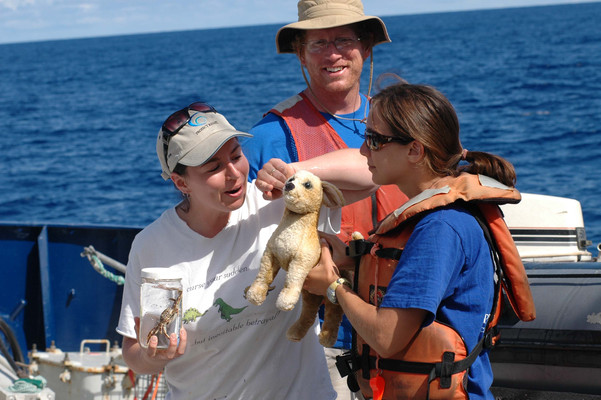
by Carolyn Gramling Thursday, January 5, 2012

SEAPLEX researchers examine a stuffed toy dog after it was collected along with ghost net debris on Aug. 15, 2009. 2009 Scripps Institution of Oceanography Photo credit: J. Leichter
Out in the middle of the northern Pacific Ocean, a giant floating mess of plastic debris is drifting and bobbing among the waves. Scientists call this expanse of litter, which stretches for hundreds of kilometers across open sea, the Great Pacific Garbage Patch. But before last summer, there was little information about how large the patch really is, what types of debris are out there and what kind of impact it is having on ocean life.
In August, a team of about 30 marine scientists from the Scripps Institution of Oceanography in La Jolla, Calif., set sail to investigate the patch on a mission called SEAPLEX (Scripps Environmental Accumulation of Plastic Expedition). During the research trip, which lasted 20 days, the team got a closer look at the debris: Much of it is tiny, the size of a thumbnail or smaller, suspended at or just below the water surface. Larger particles — which would be more easily visible to satellites — are much scarcer.
The plastic has been collecting in a part of the sea near the Hawaiian Islands, about midway between Japan and North America, known as the North Pacific Ocean Gyre. In this region, clockwise-turning currents concentrate the plastic in a convergence zone stretching hundreds of kilometers across. The convergence zone can shift seasonally to the north and south by hundreds of kilometers, pushed by ocean-atmosphere climate phenomena such as El Niño.
The plastic could be toxic to marine life, such as birds and fish, that might ingest it; but it also could alter the overall food web, by creating new places for species to collect and thrive and changing what animals are eating, said SEAPLEX lead scientist and Scripps oceanographer Miriam Goldstein at a press conference Aug. 27, following the expedition’s return. It might also contain traces of pesticides or other pollutants. To know just what sorts of impacts the plastic is already having, however, the scientists will need time to examine the expedition’s data and samples, she said. “Over the next few months, we’re going to look at the density of the debris, the size of the pieces, what types of plastic [are there] and the potential impacts.”
One glaring question is where the debris comes from — but it’s very likely an international problem, Goldstein said. “We saw trash with different writing, both from North America and Asia. But we don’t currently have a way to determine where the little pieces are from.” By studying ocean circulation patterns in the region, she added, the team hopes to better pin down those sources.
Scripps physical oceanographer Peter Niiler, who was also on the expedition, noted that the North Pacific Ocean Gyre isn’t the only place in the ocean where trash collects. Near Baja California, where the California Current converges with other water masses, another international trash pile was collecting in the late 1970s: Trash north of that front was in English, and trash south of the front was in Spanish. And “a very large amount of this trash ends up on shore,” he added at the press conference. In the Southern Hemisphere, powerful westerly winds called the “Roaring Forties” blow piles of debris into southern Chile.
“Duckies, sneakers — it’s not only our open ocean that’s collecting," Niiler said. "The entire Pacific rim is full of this plastic.”
© 2008-2021. All rights reserved. Any copying, redistribution or retransmission of any of the contents of this service without the expressed written permission of the American Geosciences Institute is expressly prohibited. Click here for all copyright requests.